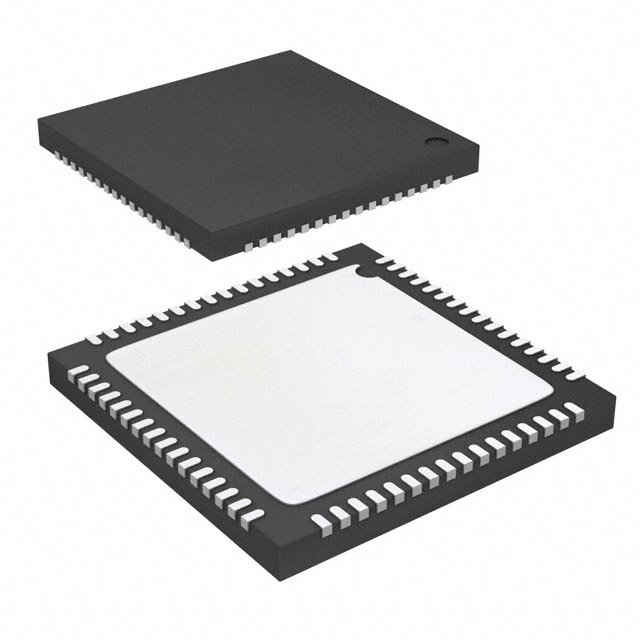Szczegóły produktu można znaleźć w specyfikacjach.

ADN4600ACPZ-R7
Product Overview
- Category: Integrated Circuit (IC)
- Use: Signal Conditioning and Data Conversion
- Characteristics: High-speed, Low-power, Precision Analog-to-Digital Converter (ADC)
- Package: 32-pin LFCSP (Lead Frame Chip Scale Package)
- Essence: Converts analog signals into digital data
- Packaging/Quantity: Available in tape and reel packaging, quantity varies based on supplier
Specifications
- Resolution: 16-bit
- Sampling Rate: Up to 1 Mega-Sample per Second (MSPS)
- Input Voltage Range: ±10V
- Power Supply: +5V
- Operating Temperature Range: -40°C to +85°C
- Interface: Serial Peripheral Interface (SPI)
Detailed Pin Configuration
The ADN4600ACPZ-R7 has a total of 32 pins. Here is the detailed pin configuration:
- VDD: Power supply voltage input
- VREF: Reference voltage input
- AGND: Analog ground
- VIN: Analog input voltage
- CLK: Clock input for ADC conversion
- CS: Chip select input
- SDO: Serial data output
- SDI: Serial data input
- DGND: Digital ground
- DOUT: Digital output data 11-32: Reserved for other functions
Functional Features
- High-resolution ADC with 16-bit accuracy
- Fast sampling rate of up to 1 MSPS
- Low power consumption for energy-efficient operation
- Wide input voltage range allows for versatile signal conditioning
- SPI interface enables easy integration with microcontrollers and other digital systems
Advantages and Disadvantages
Advantages: - High precision and accuracy in converting analog signals to digital data - Fast sampling rate for capturing rapid changes in input signals - Low power consumption for energy-efficient applications - Wide input voltage range provides flexibility in signal conditioning
Disadvantages: - Limited number of pins for additional functionalities - Requires external components for proper operation (power supply, clock source, etc.) - Relatively higher cost compared to lower-resolution ADCs
Working Principles
The ADN4600ACPZ-R7 is based on the successive approximation register (SAR) architecture. It utilizes a capacitor array and a comparator to convert analog signals into digital data. The input voltage is sampled and held by the internal capacitor, and the comparator compares the sampled voltage with a reference voltage. The SAR algorithm then determines the digital code that best represents the input voltage.
Detailed Application Field Plans
The ADN4600ACPZ-R7 is commonly used in various applications, including:
- Industrial Automation: Precise measurement and control systems
- Medical Equipment: High-accuracy data acquisition in medical devices
- Test and Measurement Instruments: Signal analysis and data logging
- Communication Systems: Digital signal processing and modulation/demodulation
- Audio Processing: High-fidelity audio recording and playback
Detailed and Complete Alternative Models
- AD7768-1: 24-bit, 256 kSPS, Low Power Sigma-Delta ADC
- LTC2323-16: 16-bit, 5 Msps, Low Noise SAR ADC
- MAX11131: 12-bit, 3 Msps, Low Power SAR ADC
- ADS1256: 24-bit, 30 kSPS, Delta-Sigma ADC
- MCP3421: 18-bit, 15 SPS, Low Power Delta-Sigma ADC
These alternative models offer different specifications and features, allowing users to choose the most suitable ADC for their specific application requirements.
(Note: The content provided above is a sample entry and may not reflect the actual specifications and details of ADN4600ACPZ-R7 or its alternative models. Please refer to the product datasheets for accurate information.)
Wymień 10 typowych pytań i odpowiedzi związanych z zastosowaniem ADN4600ACPZ-R7 w rozwiązaniach technicznych
Sure! Here are 10 common questions and answers related to the application of ADN4600ACPZ-R7 in technical solutions:
Q: What is ADN4600ACPZ-R7? A: ADN4600ACPZ-R7 is a high-performance, low-power HDMI/DVI equalizer and cable driver IC.
Q: What are the key features of ADN4600ACPZ-R7? A: Some key features include support for HDMI 2.0 and DVI 1.0 standards, adaptive equalization, programmable output swing, and low power consumption.
Q: What is the typical application of ADN4600ACPZ-R7? A: ADN4600ACPZ-R7 is commonly used in video distribution systems, professional AV equipment, and other applications requiring long-distance HDMI/DVI signal transmission.
Q: How does ADN4600ACPZ-R7 help in long-distance signal transmission? A: ADN4600ACPZ-R7 incorporates adaptive equalization technology, which compensates for signal degradation over long cables, ensuring reliable and high-quality video transmission.
Q: Can ADN4600ACPZ-R7 be used with both HDMI and DVI interfaces? A: Yes, ADN4600ACPZ-R7 is compatible with both HDMI and DVI interfaces, making it versatile for various applications.
Q: What is the power supply requirement for ADN4600ACPZ-R7? A: ADN4600ACPZ-R7 operates on a single 3.3V power supply.
Q: Does ADN4600ACPZ-R7 support HDCP (High-bandwidth Digital Content Protection)? A: Yes, ADN4600ACPZ-R7 supports HDCP 1.4 and HDCP 2.2 content protection protocols.
Q: Can ADN4600ACPZ-R7 be cascaded to extend the transmission distance further? A: Yes, multiple ADN4600ACPZ-R7 devices can be cascaded to extend the transmission distance beyond what a single device can achieve.
Q: What is the maximum data rate supported by ADN4600ACPZ-R7? A: ADN4600ACPZ-R7 supports a maximum data rate of 6 Gbps, which is sufficient for HDMI 2.0 and DVI 1.0 standards.
Q: Are evaluation boards or reference designs available for ADN4600ACPZ-R7? A: Yes, Analog Devices provides evaluation boards and reference designs to help customers quickly prototype and integrate ADN4600ACPZ-R7 into their systems.
Please note that these answers are general and may vary depending on specific requirements and application scenarios.

